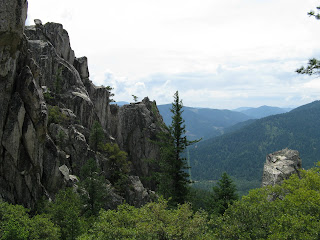The vegetation at Castle Crags is not this deeply green and lush. This image is slightly underexposed. But I like it.
Even though this image is slighty overexposed, it is truer to the hue and color of the flora of Castle Crags...Near Shasta.
If you look closely, you will see "faces" on the rock. Humans are one of the few creatures that look for patterns, facial patterns specifically, in their environment. Do you see them? Near Shasta.
A different angle of the "faces" in the rock. One of them looks like Treebeard. Castle Crags.
The clouded and majestic Shasta with the silhouette of forest in the foreground.
A different angle of Shasta with some some symmetry in the foreground.
Now Shasta with some rock and trees for balance.
This is a slab of rock balanced precariously on the edge of a granite structure. It looks out of place, even from this angle, yet nature put it there. It may not look like it, but that rock weighs at least two thousands pounds. Near Shasta.
A different angle of that "precarious" rock. Near Shasta.
This angle exemplifies even more the precarious position of our prodigal stone. Near Shasta.
And yet a different angle of the stone and its neighborhood. Shasta area.
Look closely and you'll see a sleeping giant in the rock. The peak at Castle Crags.
The sleeping giant from this angle looks a bit anguished. The peak at Castle Crags.
A different angle of the giant. Castle Crags.
And yet a different angle. This granite is big. Look at the face. Those are full-sized trees. Near Shasta.
A closer shot of the sleeping giant. Near Shasta.
If I had moved a bit to the left, the artificial (man-made) trail would not have been visible in this shot. Still, this is a decent shot of granite and vegetation. Castle Crags.
The granite formations at Castle Crags are equaled by those only of Yosemite. They are, quite frankly, confounding.
A granite outcrop that is both beautiful and mysterious. Castle Crags.
This is on the face of the sleeping giant. The elevation is high. Near Shasta.
From the face of the sleeping giant...three peaks of granite. Castle Crags.
On the face of the sleeping giant...this critter passed by me completely relaxed. My adrenaline was running high, but his wasn't. This fellow had six rattles, a button, and a mantle. That put him at 3 or more years old. And if you look closely, you will see the forked tongue working. It's interesting to note that granite formations degrade. Look at this picture and you will see the various stages. There are rock-sized, pebble-sized, and smaller-sized granite. The sand that you see is not sand at all, but granite that has degraded over time from the evironment, sun, and foot traffic from various animals. The technical term for this is decomposed granite. This is an excellent shot of a western rattler. Castle Crags.
A perspective of granite from Castle Crags.






















